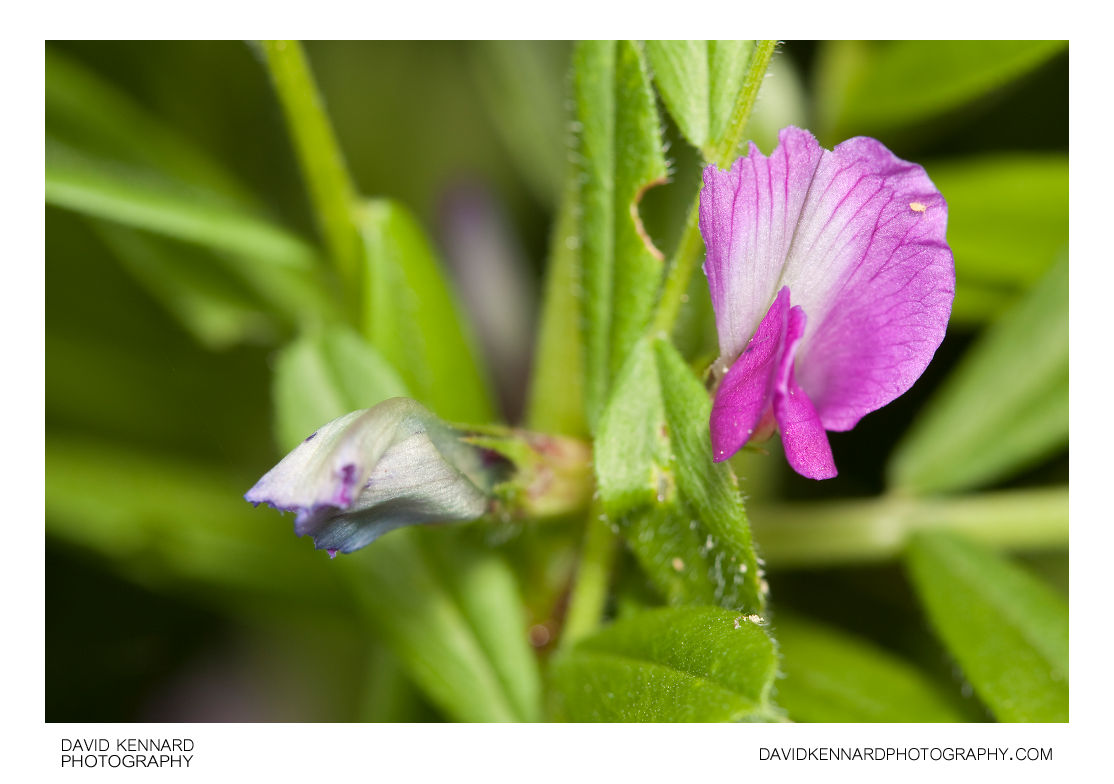Common Vetch (Vicia sativa)

Description
- Title:
- Common Vetch (Vicia sativa)
- Caption / Description:
-
Common Vetch (Vicia sativa), also known as Tare or simply "the vetch", is a nitrogen fixing leguminous plant. Although considered a weed when found growing in a cultivated grainfield, this hardy plant is often grown as green manure or livestock fodder.
When intended as fodder, the seed is sown densely, up to 250 kg/hectare. However, when grown for seed, less seed should be used; otherwise the crop will be too thick, reducing flower and seed production. When meant for seed, sowing is done early in the planting season for good returns; but, when for green food, any time between the first of April and the latter end of May is suitable. Sometimes, a full crop can be obtained even when sown as late as mid-June, though sowing so late is not recommended.
After the seed is sown and the land carefully harrowed, a light roller ought to be drawn across, to smooth the surface and permit the scythe to work without interruption. Also, the field should be watched for several days to prevent pigeons, which are remarkably fond of tares, from devouring much of the sown seed.
Horses thrive very well on Common Vetch, even better than on clover and rye grass; the same applies to fattening cattle, which feed faster on vetch than on most grasses or other edible plants. Danger often arises from livestock eating too much vetch, especially when podded; colics and other stomach disorders are apt to be produced by the excessive loads devoured.
Common Vetch has also been part of the human diet, as attested by carbonised remains found at early Neolithic sites in Syria, Turkey, Bulgaria, Hungary and Slovakia. It has also been reported from predynastic sites of ancient Egypt, and several Bronze Age sites in Turkmenia and Slovakia. However, definite evidence for later vetch cultivation is available only for Roman times.
Description from Wikipedia: http://en.wikipedia.org/wiki/Vicia_sativa
- Tags / Keywords:
-
- Biota
- Life
- Vitae
- Eukaryota
- Plantae
- Plants
- Magnoliophyta
- Flowering Plants
- Angiosperms
- Magnoliopsida
- Dicotyledons
- Fabales
- Fabaceae
- Bean
- Vicia
- Vetches
- Vicia sativa
- Common vetch
- Garden vetch
Admin
- Date Original Photo Taken:
- Original File Name:
- _MG_9327.CR2
- Event:
- Rating:
- Date this image added/last updated on website:
- Original File Dimensions:
- 4272px x 2848px
- File Type:
- JPEG
- Color Mode:
- RGB
- Original Image Color Profile:
- Adobe RGB (1998)
Location
- Location Created:
-
- Sublocation:
- City:
- Market Harborough
- Province/State:
- Leicestershire
- Country:
- United Kingdom
- World Region:
- Europe
- Geo-location:
- 52.47454212245, -0.94572441836111 View on map
Rights
- Copyright Status:
- Copyrighted
- Licensing Status:
- Rights Managed
- Available for Editorial Use:
- Yes
- Available for Commercial Use:
- Yes
- Copyright Notice:
- © 2010 Dave Kennard
Camera Data
- Date Digital Resource was created:
- Shutter speed:
- 1⁄200 s
- Aperture:
- f/6.3
- Camera Model:
- Canon EOS 450D
- ISO:
- 100
- Exposure Compensation:
- 0
- Focal Length:
- 100mm
- Focal Length (35mm equiv.):
- Metering Mode:
- Multi-segment
- Flash:
- On, Fired
- Exposure Mode:
- Manual
- White Balance:
- Manual
- Light Source:
- Exposure Program:
- Manual
Additional shooting metadata
- Lens:
- Canon EF 100mm F2.8 Macro USM
- Filters used:
- Additional Optics used:
- Setup:
- Handheld
MT-24EX Macro Twin flash with home-made diffusers
Post Processing
- Image Modified:
- Software used:
-
- Adobe Camera RAW
- Post Processing:
